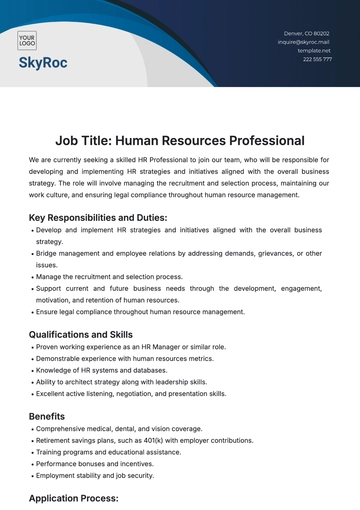Free Workplace Ergonomics Study HR

Introduction
In the digitally-driven world of [Year], the manner in which we work and interact with our workspaces has undergone significant transformations. As [Your Company Name] continues to grow and adapt, it's vital to recognize the symbiotic relationship between an employee's well-being and the environment they work in.
An ergonomic workplace isn't a mere luxury; it's an integral component of a productive, innovative, and harmonious business environment. This study delves deeply into the landscape of workplace ergonomics at [Your Company Name], emphasizing its significance and potential areas of enhancement.
Background
Ergonomics transcends mere design; it's the science of refining the job to fit the worker, rather than the contrary. Especially termed as 'human engineering,' ergonomics bridges the gap between workplace efficiency and health, ensuring that workspaces, products, and systems are tailored to those who use them.
In a landscape where employees are spending increasing durations at their desks, interacting with diverse technological interfaces, the importance of ergonomics rises manifold.
Scope of the Study
While ergonomics is a vast field, this study emphasizes the physical aspects vital for [Your Company Name]. From the layout of workstations and the ergonomics of seating to the tools and technology interfaces used daily, we delve into facets that most directly impact our team.
Rationale
The modern workforce, with its increased reliance on technology and sedentary work patterns, faces unique challenges. Repetitive strain injuries, back issues, and eye strain are becoming commonplace. By investing in a thorough ergonomic assessment, [Your Company Name] not only underscores its commitment to employee health but also anticipates the future, ensuring adaptability and resilience in ever-evolving work dynamics.
Objectives of the Study
In an era where the nature of work is continuously evolving, understanding the significance of workplace ergonomics is paramount for any forward-thinking organization. This study is crafted with specific, multi-faceted objectives to ensure a holistic approach towards optimizing our work environment.
Holistic Assessment |
To provide a comprehensive evaluation of the current ergonomic practices at [Your Company Name], scrutinizing every nuance from seating arrangements to the digital interfaces used by employees. |
Identification and Analysis |
To pinpoint areas of concern and potential ergonomic pitfalls that might contribute to physical discomfort, mental fatigue, or long-term health complications for our employees. |
Benchmarking |
To compare our current practices with global standards and industry best practices, ensuring that [Your Company Name] remains at the forefront of employee well-being and productivity. |
Employee-Centric Feedback |
To actively involve our most valuable assets, our employees, in the assessment process. This involves gathering direct, unfiltered feedback to understand their ergonomic challenges and preferences better. |
Formulating Actionable Steps |
To transition from identification to action by providing clear, practical, and evidence-based recommendations that can be seamlessly integrated into [Your Company Name]'s existing infrastructure. |
Long-Term Vision |
To lay the groundwork for an ongoing, dynamic ergonomic strategy that doesn't just address current challenges but anticipates future shifts in workplace dynamics, technology, and employee needs. |
Methodology
The quality of any study's outcomes is profoundly rooted in the methodologies it employs. Understanding workplace ergonomics at [Your Company Name] is a multifaceted endeavor, necessitating a blend of quantitative and qualitative approaches to ensure robustness and comprehensive insights. Here's a detailed breakdown of our research strategy:
Quantitative Assessment
Ergonomic Assessment Tools: Leveraging state-of-the-art software and tools to analyze workstations' physical layout, determining optimal design, alignment, and positioning for minimized strain.
Surveys: Distributing structured questionnaires to employees across all departments. These surveys delve into various ergonomic aspects, from seating comfort to digital screen usability.
Data Analytics: Using advanced data analytics tools to interpret quantitative data, identifying patterns, potential risk zones, and areas for immediate intervention.
Qualitative Analysis
Observational Studies: Deploying ergonomic experts to observe employees in their natural work environments, noting postures, interactions with tools, and behavioral patterns that could indicate ergonomic misalignments.
One-on-One Interviews: Engaging with employees in in-depth conversations, allowing them to share their personal experiences, pain points, and suggestions related to workplace ergonomics.
Comparative Benchmarking
Industry Best Practices: Researching and comparing our findings with industry leaders and global benchmarks in ergonomics. This aids in determining where [Your Company Name] stands and what steps are needed to reach or surpass these standards.
Case Studies: Delving into real-world instances of companies that revamped their ergonomic strategies, extracting lessons, and potential strategies beneficial for [Your Company Name].
Continuous Feedback Loop
Digital Platforms: Establishing an ongoing digital portal for employees to submit real-time feedback, ensuring the study's findings remain relevant and dynamic.
Iterative Testing: Introducing minor ergonomic changes in controlled departmental environments, measuring their impact before considering company-wide implementations.
Key Findings
The research methodology implemented at [Your Company Name] led to a rich tapestry of insights that are pivotal to our understanding of current ergonomic practices. The findings, summarized below, are a blend of quantitative data, observational insights, and feedback from the heart of our organization — our employees.
Notes:
The data indicates a significant number of employees face multiple ergonomic challenges, pointing towards holistic ergonomic enhancement needs.
Issues such as "difficulty in hearing during virtual meetings" suggest technological and environmental upgrades are essential.
Observational Data
Observations revealed that most workstations are not adjusted to individual employee heights, leading to potential strain.
Peripheral devices, like mice and keyboards, are not consistently ergonomic across departments.
Meeting rooms, both virtual and physical, have varied acoustics, sometimes making communication difficult.
Natural light is inconsistent across different office zones, potentially contributing to eye strain and mood fluctuations.
Qualitative Insights from Interviews and Focus Groups
A recurring theme from employee feedback is the need for adjustable workstation components, such as monitor arms and sit-stand desks.
Employees expressed the benefits of having access to ergonomic accessories, like footrests, wrist pads, and ergonomic mice.
There's a strong desire for "Ergonomic Days," where professionals could offer insights on setting up personal workspaces.
A notable percentage of employees felt that better ergonomic training could prevent many of their current discomforts.
Comparative Analysis
Comparative studies indicate that [Your Company Name]'s ergonomic standards are on par with medium-sized enterprises but lag behind global industry leaders.
Leading companies often integrate ergonomic considerations in their initial design phase, whereas at [Your Company Name], it's often an afterthought.
Successful ergonomic transitions in other companies often paired physical changes with robust training programs, highlighting the importance of awareness in achieving ergonomic success.
Ergonomic Tool Usage and Awareness:
Ergonomic Tools/Practices | Percentage of Employees Aware | Percentage Employees Using Regularly |
Sit-stand desks | 58% | 32% |
Ergonomic chair adjustments | 75% | 50% |
Screen glare protectors | 50% | 29% |
Regular screen breaks | 85% | 55% |
Proper posture techniques | 70% | 40% |
Despite a decent percentage of awareness regarding ergonomic tools and practices, actual utilization rates lag behind, suggesting the need for more practical training and reinforcement.
Recommendations
Upon thorough analysis of the study's key findings, we present a structured set of recommendations tailored for [Your Company Name]. These recommendations aim to ameliorate existing ergonomic challenges and pave the way for a healthier, more productive workplace.
Workspace Design and Infrastructure
Adopt Adjustable Workstations: Introduce sit-stand desks and adjustable chairs, ensuring that employees can tailor their work environment to their individual needs.
Optimize Lighting: Prioritize natural light, use glare-reducing fixtures, and ensure screens have adjustable brightness to reduce eye strain.
Acoustic Solutions: Invest in soundproofing for meeting rooms and open spaces to improve auditory ergonomics, ensuring clear communication and reducing disruptions.
Tech and Equipment Upgrades
High-Quality Peripheral Devices: Provide ergonomic keyboards, mice, and monitor stands. Consider tools like headsets with noise cancellation for virtual meetings.
Screen Protection: Offer anti-glare screen protectors and encourage employees to utilize blue light filters, particularly those who spend extended hours in front of screens.
Ergonomic Software: Implement software that reminds employees to take breaks, suggests posture corrections, and even offers short guided exercises.
Training and Awareness
Regular Ergonomic Workshops: Collaborate with ergonomic experts to provide training sessions. These could cover setting up workspaces, correct postures, and effective use of ergonomic tools.
Informational Material: Create and disseminate visual guides, booklets, or digital resources that employees can refer to when setting up their workstations or adjusting their routines.
Establish an Ergonomics Committee: Form a team of internal advocates who can be trained intensively on ergonomics. They can serve as points of contact for colleagues and spearhead ergonomic initiatives.
Policy Integration
Incorporate Ergonomics in HR Policies: Make it clear that ergonomics is a priority. New hires should be introduced to the company's ergonomic practices as part of their onboarding.
Invest in Employee Health: Consider partnering with local health professionals or clinics. Periodic check-ups, physiotherapy sessions, or talks on musculoskeletal health can underline the company's commitment to employee well-being.
By addressing these recommendations with intent and commitment, [Your Company Name] can usher in an era of ergonomic excellence, fostering employee well-being, and operational efficiency concurrently.
Conclusion
Ergonomics plays a vital role in not just the well-being of employees but also in enhancing their productivity and commitment to the organization. By adopting the recommendations of this study, [Your Company Name] can create a more comfortable, efficient, and health-conscious environment, underlining its commitment to employee welfare.
- 100% Customizable, free editor
- Access 1 Million+ Templates, photo’s & graphics
- Download or share as a template
- Click and replace photos, graphics, text, backgrounds
- Resize, crop, AI write & more
- Access advanced editor
Enhance workplace comfort and productivity with Template.net's Workplace Ergonomics Study HR Template. This editable and customizable tool streamlines ergonomic assessments, promoting employee well-being. Seamlessly edit using our online AI Editor Tool, ensuring tailored solutions for every workspace. Maximize efficiency and minimize discomfort with ease.





























